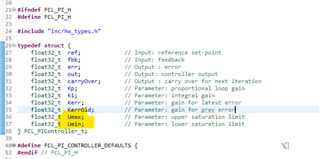您好、专家!
在双轴驱动项目中、在运行速度控制环路时、限制扭矩的正确方法是什么?
我们是否可以调整 PI_IQ 环路饱和限值(Umax 和 Umin)?-您能否确认?

我尝试减小 Umax 和 Umin、但正如预期的那样、当达到最大扭矩限值时、电机速度确实会降低。
此问题类似于用户在此线程中遇到的问题:
正如预期的那样,一旦我们将速度设定点减小到较低的值,就只能恢复速度。 如何减少这种延迟? 此处调整 PID 增益可能不是最佳选择、因为我们已经将其调整为在没有扭矩限制条件发生时正常工作。是否有其他方法来解决该问题?
谢谢。

